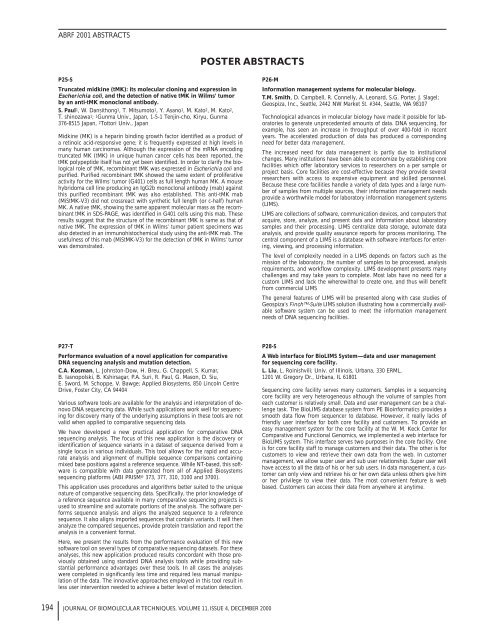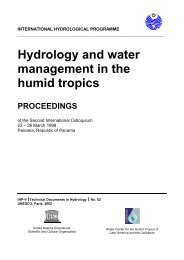FR AB - Science Reference
FR AB - Science Reference
FR AB - Science Reference
Create successful ePaper yourself
Turn your PDF publications into a flip-book with our unique Google optimized e-Paper software.
<strong>AB</strong>RF 2001 <strong>AB</strong>STRACTS<br />
P25-S<br />
Truncated midkine (tMK): its molecular cloning and expression in<br />
Escherichia coli, and the detection of native tMK in Wilms’ tumor<br />
by an anti-tMK monoclonal antibody.<br />
S. Paul1, W. Dansithong1, T. Mitsumoto1, Y. Asano1, M. Kato2, M. Kato2, T. shinozawa1; 1Gunma Univ., Japan, 1-5-1 Tenjin-cho, Kiryu, Gunma<br />
376-8515 Japan, 2Tottori Univ., Japan<br />
Midkine (MK) is a heparin binding growth factor identified as a product of<br />
a retinoic acid-responsive gene; it is frequently expressed at high levels in<br />
many human carcinomas. Although the expression of the mRNA encoding<br />
truncated MK (tMK) in unique human cancer cells has been reported, the<br />
tMK polypeptide itself has not yet been identified. In order to clarify the biological<br />
role of tMK, recombinant tMK was expressed in Escherichia coli and<br />
purified. Purified recombinant tMK showed the same extent of proliferative<br />
activity for the Wilms’ tumor (G401) cells as full length human MK. A mouse<br />
hybridoma cell line producing an IgG2b monoclonal antibody (mab) against<br />
this purified recombinant tMK was also established. This anti-tMK mab<br />
(MiStMK-V3) did not crossreact with synthetic full length (or c-half) human<br />
MK. A native tMK, showing the same apparent molecular mass as the recombinant<br />
tMK in SDS-PAGE, was identified in G401 cells using this mab. These<br />
results suggest that the structure of the recombinant tMK is same as that of<br />
native tMK. The expression of tMK in Wilms’ tumor patient specimens was<br />
also detected in an immunohistochemical study using the anti-tMK mab. The<br />
usefulness of this mab (MiStMK-V3) for the detection of tMK in Wilms’ tumor<br />
was demonstrated.<br />
P27-T<br />
Performance evaluation of a novel application for comparative<br />
DNA sequencing analysis and mutation detection.<br />
C.A. Kosman, L. Johnston-Dow, H. Breu, G. Chappell, S. Kumar,<br />
B. Iasnopolski, B. Kshirsagar, P.A. Suri, R. Paul, G. Mason, D. Siu,<br />
E. Sword, M. Schoppe, V. Bawge; Applied Biosystems, 850 Lincoln Centre<br />
Drive, Foster City, CA 94404<br />
Various software tools are available for the analysis and interpretation of denovo<br />
DNA sequencing data. While such applications work well for sequencing<br />
for discovery many of the underlying assumptions in these tools are not<br />
valid when applied to comparative sequencing data.<br />
We have developed a new practical application for comparative DNA<br />
sequencing analysis. The focus of this new application is the discovery or<br />
identification of sequence variants in a dataset of sequence derived from a<br />
single locus in various individuals. This tool allows for the rapid and accurate<br />
analysis and alignment of multiple sequence comparisons containing<br />
mixed base positions against a reference sequence. While NT-based, this software<br />
is compatible with data generated from all of Applied Biosystems<br />
sequencing platforms (<strong>AB</strong>I PRISM ® 373, 377, 310, 3100 and 3700).<br />
This application uses procedures and algorithms better suited to the unique<br />
nature of comparative sequencing data. Specifically, the prior knowledge of<br />
a reference sequence available in many comparative sequencing projects is<br />
used to streamline and automate portions of the analysis. The software performs<br />
sequence analysis and aligns the analyzed sequence to a reference<br />
sequence. It also aligns imported sequences that contain variants. It will then<br />
analyze the compared sequences, provide protein translation and report the<br />
analysis in a convenient format.<br />
Here, we present the results from the performance evaluation of this new<br />
software tool on several types of comparative sequencing datasets. For these<br />
analyses, this new application produced results concordant with those previously<br />
obtained using standard DNA analysis tools while providing substantial<br />
performance advantages over these tools. In all cases the analyses<br />
were completed in significantly less time and required less manual manipulation<br />
of the data. The innovative approaches employed in this tool result in<br />
less user intervention needed to achieve a better level of mutation detection.<br />
POSTER <strong>AB</strong>STRACTS<br />
194 JOURNAL OF BIOMOLECULAR TECHNIQUES, VOLUME 11, ISSUE 4, DECEMBER 2000<br />
P26-M<br />
Information management systems for molecular biology.<br />
T.M. Smith, D. Campbell, R. Connelly, A. Leonard, S.G. Porter, J. Slagel;<br />
Geospiza, Inc., Seattle, 2442 NW Market St. #344, Seattle, WA 98107<br />
Technological advances in molecular biology have made it possible for laboratories<br />
to generate unprecedented amounts of data. DNA sequencing, for<br />
example, has seen an increase in throughput of over 400-fold in recent<br />
years. The accelerated production of data has produced a corresponding<br />
need for better data management.<br />
The increased need for data management is partly due to institutional<br />
changes. Many institutions have been able to economize by establishing core<br />
facilities which offer laboratory services to researchers on a per sample or<br />
project basis. Core facilities are cost-effective because they provide several<br />
researchers with access to expensive equipment and skilled personnel.<br />
Because these core facilities handle a variety of data types and a large number<br />
of samples from multiple sources, their information management needs<br />
provide a worthwhile model for laboratory information management systems<br />
(LIMS).<br />
LIMS are collections of software, communication devices, and computers that<br />
acquire, store, analyze, and present data and information about laboratory<br />
samples and their processing. LIMS centralize data storage, automate data<br />
analysis, and provide quality assurance reports for process monitoring. The<br />
central component of a LIMS is a database with software interfaces for entering,<br />
viewing, and processing information.<br />
The level of complexity needed in a LIMS depends on factors such as the<br />
mission of the laboratory, the number of samples to be processed, analysis<br />
requirements, and workflow complexity. LIMS development presents many<br />
challenges and may take years to complete. Most labs have no need for a<br />
custom LIMS and lack the wherewithal to create one, and thus will benefit<br />
from commercial LIMS<br />
The general features of LIMS will be presented along with case studies of<br />
Geospiza’s Finch-Suite LIMS solution illustrating how a commercially available<br />
software system can be used to meet the information management<br />
needs of DNA sequencing facilities.<br />
P28-S<br />
A Web interface for BioLIMS System—data and user management<br />
for sequencing core facility.<br />
L. Liu, L. Roinishvili; Univ. of Illinois, Urbana, 330 ERML,<br />
1201 W. Gregory Dr., Urbana, IL 61801<br />
Sequencing core facility serves many customers. Samples in a sequencing<br />
core facility are very heterogeneous although the volume of samples from<br />
each customer is relatively small. Data and user management can be a challenge<br />
task. The BioLIMS database system from PE Bioinformatics provides a<br />
smooth data flow from sequencer to database. However, it really lacks of<br />
friendly user interface for both core facility and customers. To provide an<br />
easy management system for the core facility at the W. M. Keck Center for<br />
Comparative and Functional Genomics, we implemented a web interface for<br />
BioLIMS system. This interface serves two purposes in the core facility. One<br />
is for core facility staff to manage customers and their data. The other is for<br />
customers to view and retrieve their own data from the web. In customer<br />
management, we allow super user and sub user relationship. Super user will<br />
have access to all the data of his or her sub users. In data management, a customer<br />
can only view and retrieve his or her own data unless others give him<br />
or her privilege to view their data. The most convenient feature is web<br />
based. Customers can access their data from anywhere at anytime.















